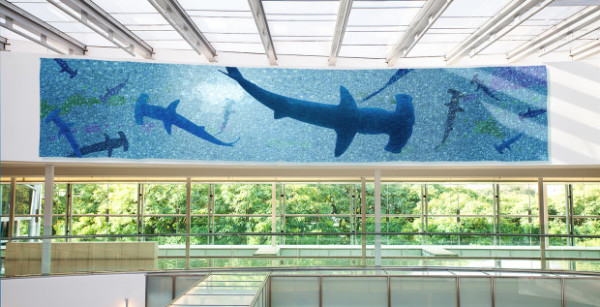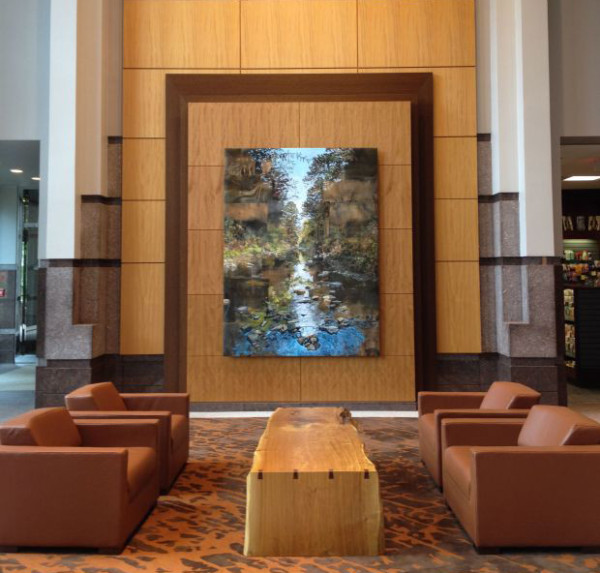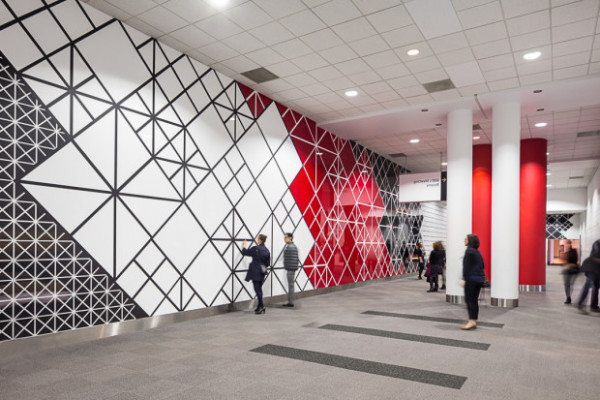Second of a 3-part series on the business of art consulting by Peter Hite

In the first article of this series, we covered the basics of art consultants: who they are, why they matter to you as an artist, and how you can find compatible consulting firms. Remember that a single well-matched art consulting relationship will be much more fruitful than a dozen poorly matched ones—so don’t be afraid to spend time researching before you take any next steps.
Once you have put in the effort and identified several consultants who seem like a good fit, you, of course, have to actually reach out to them. The commissions won’t come to you unless the consultants respond to your emails or find you on CODAworx.
And that’s what we’ll be exploring today: how art consultants prefer to be contacted and how to make a memorable first (or second…or third…) impression.
Art Consultants Appreciate Emails
The bottom line is this: Consultants overwhelmingly prefer artists to introduce themselves via email. As Jennifer Perlow, founder of PS Art Consulting, says, “Email is how I stay up to date on what artists are doing.”
However, as we’ve mentioned before, the consulting world is quite fragmented—which means that email preferences vary. In general, solo consultants or small firms can be emailed directly. Larger firms, on the other hand, tend to have a set structure in place to receive artist emails. These systems range from a dedicated email address for artists to administrators who manage submissions and sometimes even an online database.
For firms of any size, it’s important to follow the directions on the website. If no directions are listed, email the consultant directly.

Five Tips for Effective Emails to Art Consultants
A simple, well-crafted email is the quickest way for art consultants to meet artists or get an update on recent work. “Artists’ emails to help me stay up-to-date and find the best work for my projects but it’s worth mentioning that Facebook and Instagram are great resources for artist updates,” said Atlanta-based consultant Anne Lambert Tracht.
Because art consultants are busy, it’s best to keep your emails as simple as possible. Follow these tips to make it easy for the consultant to see your work:
- Send mostly images with short text. Most art consultants won’t read the text carefully, but they will look at the images.
- Include all important information. Although brevity is important, so are the key details of your artwork. “Make sure the artwork medium, size, retail price and other relevant information is listed,” notes Pamela Marshal of Novus Art Consulting.
- Embed images in the email itself. This eliminates the extra step of opening an attachment. Attachments can be added in addition, if you want.
- Send appropriate file sizes. Though bandwidth speeds have increased dramatically, you still shouldn’t be sending bloated files. JPEGs at about 1500×1000 @ 72 dpi are ideal.
- Link to your website. Interested consultants may visit your website for more information. They may even pull images from your website to show their clients. (One extra tip here: If you have poor-quality or watermarked images on your site, you may be decreasing your chances of being selected. “If I need to contact the artist for images that don’t have watermarks, it adds time and more steps for me,” noted Amy Parry, a hospitality consultant.
Like any other communication with art consultants, introductory emails should be easy to read and digest. Because this is your first interaction, it’s important to send an overview of your work so that the consultants can quickly determine whether you fit in with their consulting practice or not. Your introductory email should include about 10 images (including a few detail shots), your contact information, and key information like artwork size, medium, etc. I like to embed them in the email, not send them as attachments because it saves them time.
While some artists also include pricing in their emails, I withhold this information until asked. I do that for two reasons: 1) I don’t want to scare off the consultant because of price, and 2) a price request indicates a level of interest in my work.
No Reply? Don’t Panic!
Even though email is the preferred method of communication, most consultants don’t reply to artist emails. You may occasionally receive a brief response—but don’t count on it.
If that seems rude, it isn’t meant to be. Remember, art consultants are busy! In fact, the consultants I spoke to receive an average of 30 emails a week just from artists sharing their work. “I wish I could respond to all emails, but it is a daunting task since we receive so many each day. We don’t have a profession without artists so it is especially hard not to be able to respond to everyone,” said Washington, D.C.-based consultant Jean Efron.
So what does the silence really mean? Many things:
- I don’t like your work.
- It’s okay (or even great!), but it’s not a good fit for me.
- I like it, but I am way too busy to respond.
- I like it, but I don’t have an immediate project for it now.
- I like the work, and I’m showing it to clients but not telling you.
Emailing consultants is like putting a message in a bottle. You never know when or if you will hear back. But that’s okay—it’s not about the immediate response. The goal is to be seen as a professional artist who is a reliable creative partner.

The Other Key to Success: High-Quality Photographs
As you’ve probably noted already, photographs of your artwork make up a good portion of your emails to art consultants. And quality photographs absolutely make a difference.
Let’s look at why.
When consultants meet with a client about a commission, they show work from upwards of 20 different artists to determine what resonates most. In that scenario, you are competing against all of the other artists—and you may not even know that you’re in the running!
In fact, any photographs you’ve sent by email may be used by the consultants at any time. If a consultant likes your work and has a project that you fit, it’s common for him or her to present your images without you even knowing it.
For that reason, it’s critical to represent your work as professionally and fully as possible, which is where high-quality photographs come in.
Five Tips for Effective Photographs
To give yourself a good chance of selection (both by the art consultant and eventually the client), high-quality photographs will be one of your best resources. Here are a few tips for making the most of your photos, even without a DSLR camera:
- Learn from the pros. I suggest watching a few videos on how to improve the lighting of your artwork. Good lighting will improve your images much more dramatically than an expensive camera. Similarly, professional post-processing work in Photoshop is often much more effective (and affordable) than hiring a photographer.
- Cover all angles. Take images from various distances and angles so that your work is well represented. Pamela Marshal of Novus Art Consulting notes her preferred photography spread: “Ideally, I like to see three views of the artwork: a detail, the full artwork, and an installation shot if possible.”
- Show the work installed. As Pamela Marshal says, images of installed commissions are ideal. They say the most without any written description by showing the size of the artwork through the context of the space, the type of client it was made for (corporate, healthcare, hospitality, residential), and the level of commission. Is it in a boardroom or next to the broom closet? A higher-profile space indicates that you are a trusted creative partner who was given a bigger budget for an important client.
- Get help from your consultant. This tip goes hand in hand with the previous one. Most artists, including myself, rarely get to see the final installation. And because it can be prohibitively expensive to hire a professional photographer, artists often have no easy means of getting installation shots. So what’s the solution? Ask your art consultant to photograph the installed artwork! In my experience, most art consultants are happy to do it. Just be sure to provide specific direction on the kinds of shots you want: how many, from which angles, at what distance, under what lighting, and so on.
- View plenty of examples. Before your art is ever commissioned or installed, spend some time browsing photographs on CODAworx.com. This will give you some great insight into what kind of pictures best draw the eye.
Some artists love taking photographs of their work; others find it little more than a distraction. Whichever category you fall into, remember this: When your artwork is being pitched to potential clients, it’s your images that they see, and these images are speaking on your behalf to someone who knows nothing about you, and maybe nothing about art at all.
The consultant may say a few words, but it’s your imagery that speaks the loudest. So shouldn’t you make sure it’s saying something positive?
Here’s how Chris Roth, curator at NINE dot ARTS, sums up the importance of photography. “Images are the primary way we communicate to clients what a commission would look and feel like. As an artist, you are doing yourself a great disservice if you don’t take the time to properly photograph your work.”
Emails and Photographs: Why Presentation Matters
As artists, it can be easy to get wrapped up in our own work. It’s easy to think that our work is all that matters. And while the quality and style of your artwork certainly plays an important role in any commission selection, you won’t even be seen by potential clients unless you can first connect with art consultants.
That’s why it pays to invest in your communication skills and the presentation of your artwork. After all, the way you present your work is a reflection of you as an artist. The goal is to be seen as a professional and reliable creative partner—and the content of your emails and quality of your photographs speak volumes.
In the next and last article of this series, we’ll be covering a topic that’s important but sometimes shrouded in mystery: money. We’ll look at how art consultants run their businesses and how that impacts you as an artist. I’ll also give you a start-to-finish look at the entire commission process so you’ll know exactly what to expect. See you next time!
———–
This is the second of a series of three articles on private art commissions. The first article is Where to Start the Commissioned Art Process and the third is What to Expect Regarding Money and the Full Commission Funnel.
Peter Hite is an artist who creates site-specific mosaics made from postage stamps.
Special thanks to Robin Ficara.